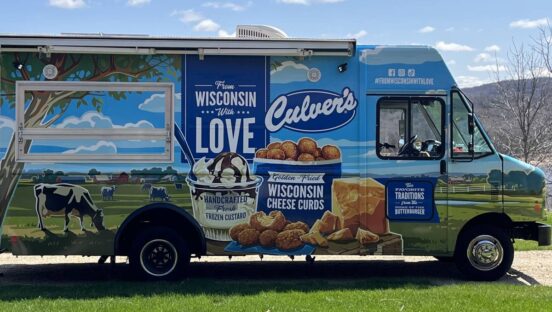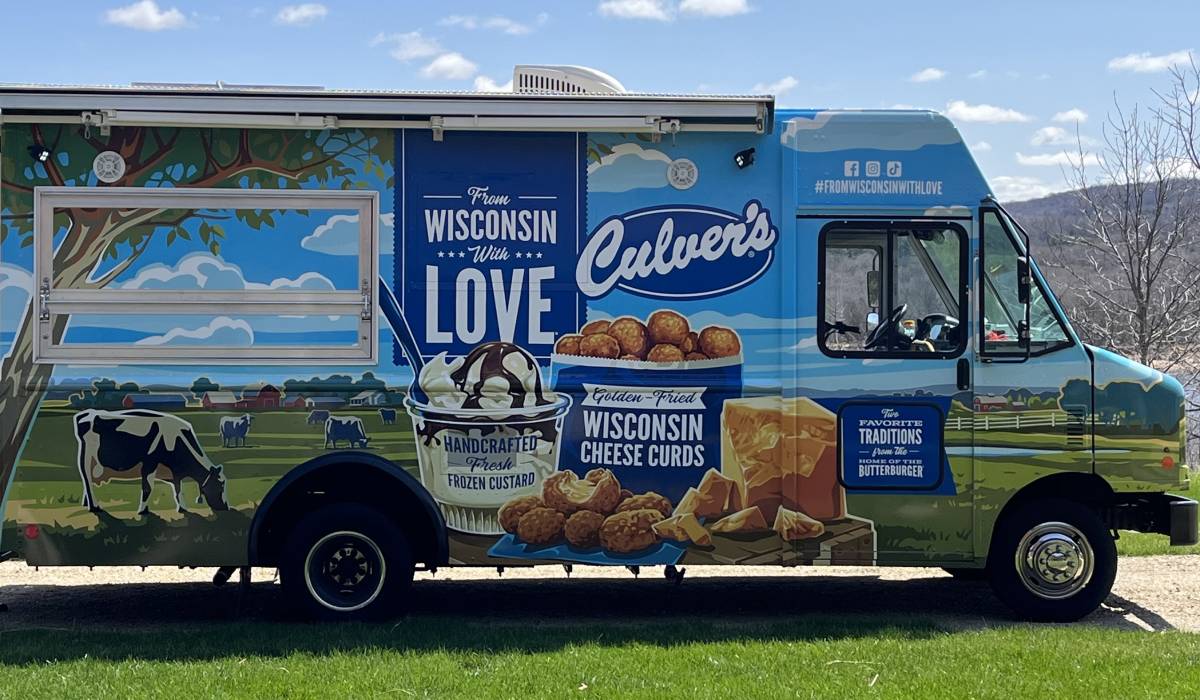Sitting along the winding Wisconsin River in southern Wisconsin, the town of Sauk City was originally the site of an ambitious Indian village, one that an 18th century visitor called “the largest and best built Indian town [he] ever saw.”
“It contains about 90 houses, each large enough for several families. The streets are regular and spacious,” adventurer Jonathan Carver wrote to friends on October 9, 1766. Nearly a century later, Sauk City was incorporated, making it the Badger State’s oldest incorporated village and one with a passion for daring and zeal engrained in its civic DNA.
Today, Sauk City, located about 25 miles northwest of Wisconsin’s capital, Madison, calls itself “a true Midwestern village,” a 3,000-resident community where people value a good day’s work, look out for neighbors, and cherish the American Dream.
Sauk City’s history and heart make it a fitting birthplace for Culver’s, the ButterBurger and frozen custard shop that Craig Culver founded with his wife, Lea, and parents, George and Ruth, on July 18, 1984. From that converted A&W restaurant on U.S. Route 12, Culver’s has matured into a national quick-service power player.
In 2014, Culver’s 30th on the American entrepreneurial map, the quick-service chain celebrated a year of milestones. It opened its 500th store, saw its average unit volume (AUV) climb over the $2 million mark, and topped $1 billion in systemwide sales for the first time in company history.
“A lot of people through the years said, ‘When you get to 100 restaurants, things will be so much different,’ but we’ve just kept doing what we do and, lo and behold, we’ve become a $1 billion company,” says Culver’s CEO Phil Keiser, a 19-year Culver’s employee who entered the company’s corner office in June following the quasi-retirement of 65-year-old cofounder Craig Culver.
Indeed, Culver’s ascent has been consistent and calculated. One decade ago, Culver’s sat in the 40th position in this magazine’s annual QSR 50 report, with 272 units and systemwide sales of $423 million. Today, those numbers have more than doubled, as the ButterBurger-peddling chain found in 22 states continues to climb the ranks of the quick-service elite. In this year’s list of industry giants, Culver’s now sits in the 27th position.
“They’re in the big leagues now,” longtime industry observer and WD Partners foodservice strategist Dennis Lombardi says of Culver’s.
Whereas some quick-service concepts push the value button, Lombardi says, Culver’s found a sweet spot on the premium end of quick service, scoring high marks with consumers on food quality, cleanliness, service, and menu variety.
“When you hit on some of those key factors time and again, it makes customers more likely to return and to recommend the restaurant to others as well,” Lombardi says. “It’s a solid winning formula.”
People: The core of Culver’s rise
Without hesitation, Keiser calls people the primary reason Culver’s has grown from a regional chain into an emerging national name.
In this day and age, it seems a trite, hackneyed statement. But in Culver’s case, it’s undeniably true.
The Culver Franchising System, the company’s formal franchising entity established some 28 years ago, continues placing its bets on the owner-operator model, preferring to award its franchises—the system is about 99 percent franchised—to entrepreneurs committed to being in their restaurants every day. Franchising conglomerates, sound as some surely are, need not apply.
Keiser says the owner-operator model delivers a long-term view, heightened attention to detail, and results that have propelled the concept’s ascent.
“We enjoy some of the best franchise partners in the restaurant industry,” Keiser says. “They are present and engaged in our business, and they are working toward execution and looking for things that they can do better within their four walls each and every day.”
The groundwork for that relationship and the culture it breeds begins early in the franchising process. Before any entrepreneur is considered for a Culver’s franchise, the prospect must complete a discovery week, which includes working six 10-hour days in the restaurant. Though this step often slows Culver’s ability to award and, subsequently, open new stores, Keiser is convinced it’s the right move for the brand and its future.
“We’re good at teaching people how to cook the burgers and clean the restaurants, but we want people with the right life skills and core values, partners who view people, product, and the community in a way that aligns with us,” Keiser says. “That’s an absolutely critical first step.”
If selected, franchise partners attend a comprehensive 16-week training program—ButterBurger University—before heading to their restaurant for full-time duty. This same training program extends to store managers, which not only increases the number of people with a stake in each unit’s success, but also spurs expansion opportunities for store owners already within the chain’s franchisee pool.
Last year, about 1,500 people attended ButterBurger University in Prairie du Sac, Wisconsin, says Culver’s senior vice president of operations and training, Jeff Bonner. In addition to the comprehensive training for new franchisees and managers, the company also offers ongoing workshops addressing issues such as equipment and profitability to ensure that franchise growth coincides with proper training, education, and professional growth.
“This is key to maintaining our culture here at Culver’s,” Bonner says, noting that Culver’s opened a new 47,000-square-foot support facility in Prairie du Sac in 2009.
As Culver’s has moved from 100 stores to more than 500, the formal onboarding of new franchisees and existing managers, combined with the company’s field consultants—each of whom oversees 20–25 stores and visits restaurants daily—has helped the chain solidify its culture and fuel its success. Since beginning franchising in 1990, in fact, only two Culver’s units have closed.
“That’s a difficult thing to do, but Culver’s has done it because Craig Culver had a drive to have the customer experience be what it is and the team around him shared that same purpose,” Lombardi says, adding that Culver’s owner-operator model concentrates each owner attention to one, two, or maybe three units.
“There’s a lot more need, desire, and awareness to have the store running just as it needs to run when you have such high personal stakes in the business,” Lombardi says.
Those same operators, then, translate Culver’s culture of hospitality down to crewmembers. Each Culver’s restaurant employs 30–75 team members throughout the year, with about 10 summertime positions added to satisfy peak demand.
“Culver’s crew people are helpful and look like they’re proud and enthusiastic to be there, which helps customers enjoy a more personal touch,” Lombardi says.
[pagebreak]
Culver’s corporate office has worked to strengthen its relationship with front-line employees, especially teens and young adults, through its VIP (Very Important Partners) Scholarship Program. Founded in 1993, the VIP program helps team members pursue higher education and has awarded more than $2 million to more than 1,800 team members to date.
“We know, without a doubt, that people are central to our success, so we’re going to invest in them over and over,” Keiser says.
Pushing points of differentiation
Culver’s has increasingly pushed its premier points of differentiation, particularly on the menu front.
While better-burger players continue flooding the quick-serve and fast-casual arena, Culver’s has stayed true to its core: serving its fresh, never frozen, and made-to-order Midwest-sourced burgers on a lightly buttered toasted bun. (Culver’s even hosts an annual National Grill Master Competition in which team members throughout the system compete for ButterBurger preparation supremacy.)
Keiser does not view the still-escalating emergence of better-burger concepts as an impediment. Rather, he considers the competition a benefit to Culver’s, saying it heightens awareness of the category and spotlights burgers as America’s food.
“A number of these players have raised the bar on what people think is a good burger, and we like competition because it makes us stronger,” Keiser says. “Our approach is, ‘Welcome to the neighborhood. Game on.’”
Those same competitors, Keiser adds, have also pushed Culver’s to up its game in other areas, to become more disciplined operationally, and to better articulate and identify its success factors. For example, a guest feedback program, now in its fourth year, has helped Culver’s leadership identify a number of strategic priorities, including improving the accuracy and hospitality of the drive-thru experience, finding ways to better welcome first-time guests, and improving business on nights and weekends.
“Our operators buy in, and it’s helped improve our operations,” Bonner says.
After its signature ButterBurgers, Culver’s touts its frozen custard as another key differentiator. A thicker, creamier, less airy version of ice cream, Culver’s frozen custard is crafted from real Wisconsin dairy pulled from 5,400 local cows and made fresh within the restaurant each day.
The chain’s popular “Flavor of the Day” program, meanwhile, features more than 80 rotating flavors, including favorites like Cookie Dough Craving, Turtle, and Mint Chip. Each Culver’s store creates its own “Flavor of the Day” calendar, which customers can see daily on the store marquee, in a five-day forecast within the chain’s mobile app, or on the company website.
The chain has consistently worked to broaden its menu as well, finding inspiration in Wisconsin’s supper clubs with items such as hand-battered North Atlantic cod, genuine Wisconsin cheese curds, beef pot roast, fried chicken, and butterfly jumbo shrimp.
“This kind of menu diversity eliminates the veto vote for parties coming and going, but also gives Culver’s more opportunity to drive frequency and reach into the dinner daypart,” Lombardi says.
It’s a message Craig Culver, who continues to provide leadership as chairman of the board, champions in the company’s “Welcome to Delicious” marketing campaign.
“It’s very effective when the founder can get out and tell a story that people appreciate,” Keiser says of the television spots featuring his longtime boss.
While escalating food costs continue to challenge Culver’s, as they do eateries across the country, Keiser says his team leverages its company-wide POS system to assess hits and misses to ensure stores remain at competitive price points, protect margins, and achieve balanced results.
“We do quite a bit of reflection here,” Keiser says, adding that Culver’s maintains its eyes on consumer desires related to nutrition and ingredients as well, a reality that sparked the release of a gluten-free bun last March.
The earnest reflection extends into Culver’s dining rooms, where an ongoing restaurant reimaging program has delivered contemporary and inviting dining rooms that seat 98–118 guests. Today, Bonner reports that more than half of the Culver’s system meets brand standards as the chain’s franchise partners consistently reinvest in their units.
It’s that perpetual, diligent focus on improvement that has fueled Culver’s remarkably steady and substantial growth. The chain, Keiser says, does not make changes for change’s sake, nor overreact to market conditions.
“We try to avoid the real highs and the real lows,” Keiser says.
Nothing will change moving forward, Keiser assures, as Culver’s plans to continue its disciplined approach to operations and, in particular, development. The company, which has historically concentrated store development in concentric circles from its Wisconsin base, isn’t rushing to all corners of the country, but rather seeking critical mass in existing trade areas such as Chicago, Indianapolis, St. Louis, and Kansas City.
“Once you make a commitment to market, you have to grow it,” Keiser says. “We’re not interested in opening the most restaurants. We’re interested in opening successful restaurants.”
So long as Culver’s continues to secure strong unit economics, Lombardi sees no slowdown to its steady pace.
“If they can continue what they’re doing, Culver’s has a lot more room to grow and many more milestones to hit,” Lombardi says.
On the heels of opening 33 new restaurants and hitting significant financial benchmarks in 2014, Culver’s looks to continue that momentum in 2015 and launch as many as 40 new eateries by year’s end.
“We don’t feel we need to go out and do things differently,” Keiser says. “We trust the plan and believe good things will come.”








